Tattoo Healing Process: Do's and Don'ts For Tattoo After-Care
Tattoo Healing Process: Do's and Don'ts For Tattoo After-Care
Proper tattoo after-care is the best predictor of success during the tattoo healing process. The right tattoo after-care instructions protect your skin health and preserve your fresh ink – both in the short and long term. Remember, a new tattoo is a dressed-up skin wound and requires the same level of taking care in its unhealed state. Diligently implement these tattoo after-care practices over the first few weeks to prevent skin infection, irritation and keep your tattoo from fading prematurely.
Your tattoo artist should always be your go-to authority on how to best care for your new ink. Make sure to follow your vetted expert’s instructions precisely. Don’t be shy to ask questions during your session or check in after your appointment for additional instructions, personalized questions, concerns or tips if needed. For some general guidelines, these best tattoo after-care practices offer some tried-and-true advice that you should know – whether it’s your first or fiftieth time getting inked.
Here’s an overall guide on the most important tattoo after-care do’s and don’ts to know throughout every stage of the healing process.
Tattoo After-care Do’s During The Healing Process:
Establish A Consistent Hygiene Routine
A clean tattoo wards off infection and keeps the healing time to a minimum. Cleanse the tattoo with fragrance-free antibacterial soap and lukewarm water once you can remove the initial bandage (usually around 3-24 hours after getting your tattoo). Gently pat the area dry and follow up with a moisturizing ointment or cream, like Zensa Healing Cream. Practice this cleansing routine twice a day for 4-6 weeks until your tattoo is fully healed. After the tattoo healing process, you can ease up on this regimen and wash the inked area the same way you clean the rest of your skin.

Always wash your hands before touching or cleaning your new tattoo. Unwashed hands can transfer bacteria, dirt, oil and other germs into the fresh wound, which creates a breeding ground for fungal, bacterial and viral infections (or clogged pores). Any of these disruptions during the tattoo healing process can cause skin irritation and permanent damage to the look of your tattoo’s ink and design.
Regular Moisture Matters
Daily hydration is essential for proper tattoo after-care and supports every stage of the healing process. Moisturizing freshly-inked skin protects against cracking, bleeding and prevents dry, itchy skin. Like any fresh wound, a new tattoo creates skin trauma and repairs itself by replacing the damaged tissue with a fresh layer of healthy skin. Frequently hydration nourishes the skin’s moisture barrier. A strong moisture barrier makes the skin more resilient, stimulates collagen production and increases cellular turnover to accelerate the wound healing process. These benefits can aid in the scab-formation process – jumpstarting this stage of the tattoo recovery process.
Once the scabs thicken, they will start peeling or flaking off to unveil the new layer of healed skin. Tattoo lotion and frequent hydration are most crucial during the peeling stage of your tattoo after-care journey. Regularly moisturize the skin to prevent it from drying out, irritation or infection. These benefits of tattoo lotion help minimize this peeling to keep your tattoo from fading prematurely and reduce patchiness or scarring during the healing process.
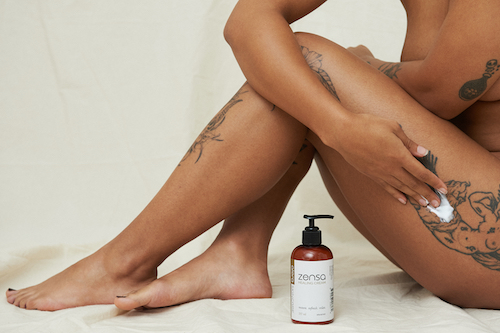
Apply a thin layer of an artist-recommended product like Aquaphor or Zensa Healing Cream twice daily after cleansing for best results. Using too thick of a layer or over-moisturizing the tattoo can clog your pores, lead to breakouts and leave you with cracked skin.
Zensa Healing Cream contains medicinal-grade ingredients, including calendula and grapefruit oil, to speed up tattoo healing and reduce skin irritation. The product also features shea butter and cucumber extract to hydrate and soothe the skin with sunflower seed oil that brightens and preserves the tattoo’s original colour without impeding ink settling.
Stay Dry (Whenever Possible)
An overly wet or moisturized tattoo can cause skin infection, irritation and improper ink settling. Excess moisture leaves the wound more susceptible to bacteria, fungus or other microbial exposure that can infect the skin. Drenching a new tattoo in water or too much lotion clogs your pores, which can inflame or dry out the skin – resulting in potential breakouts, scarring and patchy ink.
Always pat (never rub) your skin dry with a fresh paper towel after taking a shower or washing your tattoo. Don’t submerge your new ink under the showerhead or take a bath during this initial healing period. Generally, stick to applying a tattoo lotion, ointment or healing cream up to 3 times a day. Don’t pile it on as a thick layer. You can always use more of the product later if needed.

Use Fresh Towels & Sheets
Staying on top of your laundry schedule is particularly important when you have a new tattoo. Make sure to have clean sheets before going to bed with fresh ink. Use an old set that you won’t mind throwing away after a couple of days. The ink and bodily fluids (blood, plasma, etc.) can seep onto the bed sheets during the first night or two with a fresh tattoo and might be permanently stained. Make sure to ask your artist about the best nighttime after-care practices for your tattoo. If recommended by your expert, consider using a Saniderm bandage to control tattoo weeping after taking off your initial wound dressing. Typically, you can wrap your tattoo at night for up to 3-4 days after getting your tattoo. Remember to apply a tattoo ointment, lotion or healing cream underneath.
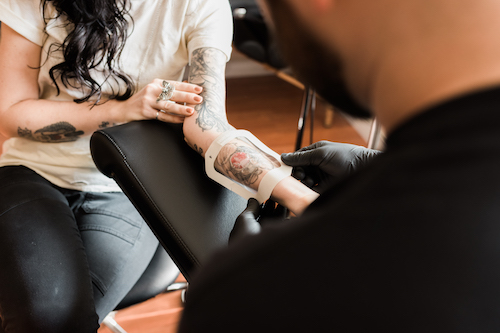
Wash and change your sheets as often as possible during the initial 4-6 week tattoo healing process. Sleeping on unclean sheets leaves your tattoo vulnerable to dirt, germs or oils that can cause an infection or skin irritation.
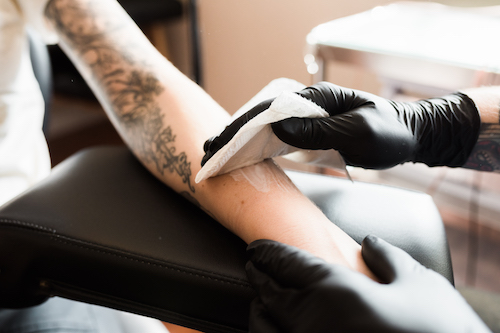
Similarly, you always want to use a clean towel on your skin when you have a new tattoo. Use a fresh paper towel every time you clean your tattoo. Never use a washcloth or a similar bath towel to rub or pat your tattoo dry. Any cloth towel could be harboring some germs or bacteria (it’s better to let the ink air dry). Wash or change out your towel when you shower to minimize exposure to any microbes that could lead to infection.
Wear Loose Clothing
Fresh tattoos need room to breathe. Tight-fitted clothing can rub against the skin, hindering the healing process or damaging the wounded tissues, and trap moisture that can lead to infection, skin rashes or other inflammatory conditions. Garments made from cotton or organic cotton are generally considered the best options right after getting a tattoo. Choose soft and relaxed-fitting silhouettes whenever possible, especially when going to sleep or working out (once you’re able to do so).
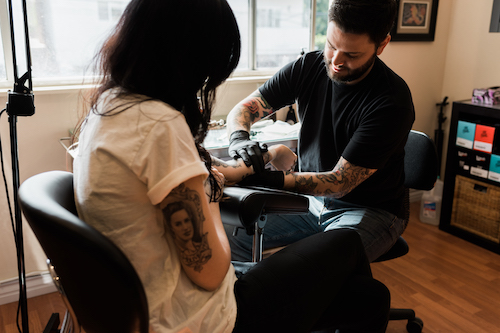
Consult A Doctor If Needed
While some bleeding, oozing and itching are normal, never hesitate to contact a medical pr ofessional if your symptoms feel or look more severe than common side effects. Your artist should give you a full guide and lesson on the difference between normal healing and after-care warning signs.
Severe side effects, including severe skin rash, oozing, itching or feeling feverish, require immediate medical attention. These are all signs that your tattoo could be infected or that you’re having an allergic reaction.
Tattoo After-Care Don'ts During The Healing Process:
Don’t Leave Your Initial Covering On Too Long
Most artists recommend that you leave your initial tattoo bandage on for anywhere between 3-24 hours. However, the guidelines for your specific design will depend on the size and placement of your tattoo, among other personal factors. The type of bandage used also determines how long an artist will recommend you to keep this initial dressing on. If they use plastic film, then you usually need to take off the bandage anywhere from 2-4 hours after getting your tattoo. When they use protective tattoo film, you might be able to leave this first dressing on for up to 24-48 hours (including overnight). Once this initial protective tattoo film is removed, you can wash your tattoo and use a new bandage if your artist recommends it. Follow your expert’s exact instructions on when to take this bandage off.
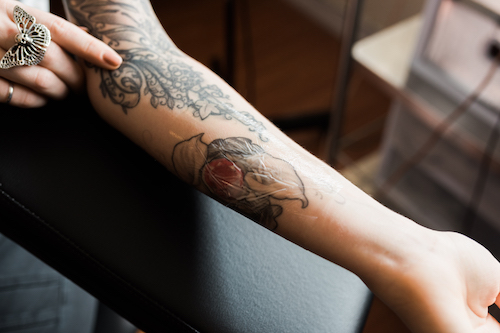
When you see a considerable amount of blood and plasma, it is time to take off or replace your bandage. Always wash a fresh tattoo with mild antibacterial soap and lukewarm water immediately after taking the dressing off.
Waiting too long to remove your tattoo bandage can cause an infection (from trapped moisture and bacteria) or result in lost ink within several hours of getting your piece done.
Never Pick At Your Scabs
After around 4 days, scabs should start to form during the wound healing process. As these scabs thicken over the next couple of days, they should begin to peel and unveil a fresh layer of healed skin. This healing stage should last for around a week.
While they may look unsightly, there’s never a reason to pick these scabs. If you give in to this urge, you can cause an infection, scarring, allow germs or bacteria into the tattoo or remove ink from the piece (giving you a patchy tattoo). Make sure to diligently moisturize the area with your tattoo ointment or lotion during this stage of the tattoo healing process. Keeping this skin well-hydrated prevents cracked or dry, itchy skin and minimizes peeling.
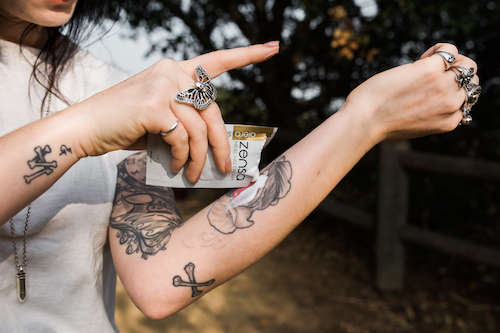
No Sweating, Swimming, Soaking or Shaving
Any excess moisture can become a breeding ground for wound infection. Activities that leave you sweaty (from exercise and saunas to sex and hot showers) provide ample opportunity for bacteria to seep into your pores and harm your tattoo, slow the healing process and result in more serious complications in rare cases. It is best to wait around 2 weeks after getting your new tattoo to resume vigorous exercise. However, you may be able to do some workouts 2-3 days after your tattoo starts healing. Do not soak in your bathtub, wet your tattoo directly under the showerhead or go in pools, oceans and other communal bodies of water until your piece is fully healed (around 6 weeks). Wait until your tattoo is fully healed to start shaving on the inked area as well. Before shaving, run your fingers over the area to ensure the ink is not raised. If you don’t notice any bumps after this timeframe, it should be safe to use a razor blade on this patch of skin.
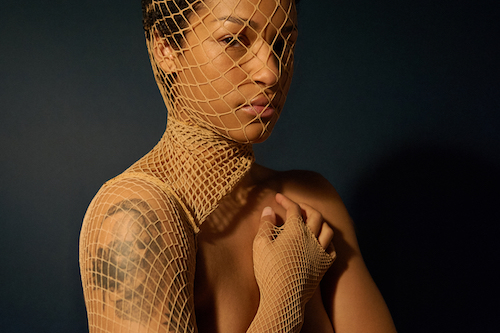
Avoid Sun Exposure
During the tattoo healing process, it is particularly important to protect your new tattoo from direct sunlight. Unlike a healed tattoo, you can’t put sunscreen on an open wound. Make sure to cover your tattoo with loose-fitting clothing whenever you step out into the sun. Once the ink is fully healed, always put sunscreen on your tattoo if you know it will be exposed to the UV rays. Not only is sunscreen crucial for your skin health, but it also prevents your tattoo ink from fading – whether they’re old or new. Sunburns can also cause damage to the appearance of any tattoo. Add as many layers of sun protection as possible to preserve the look and health of every tattoo.
Learn more about some easy habits to prevent your tattoo from fading HERE.
